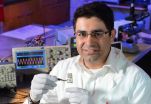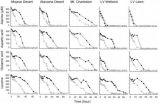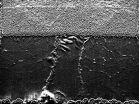(Press-News.org) AMES, Iowa – A medical device, once its job is done, could harmlessly melt away inside a person's body. Or, a military device could collect and send its data and then dissolve away, leaving no trace of an intelligence mission. Or, an environmental sensor could collect climate information, then wash away in the rain.
It's a new way of looking at electronics: "You don't expect your cell phone to dissolve someday, right?" said Reza Montazami, an Iowa State University assistant professor of mechanical engineering. "The resistors, capacitors and electronics, you don't expect everything to dissolve in such a manner that there's no trace of it."
But Montazami thinks it can happen and is developing the necessary materials.
He calls the technology "transient materials" or "transient electronics." The materials are special polymers designed to quickly and completely melt away when a trigger is activated. It's a fairly new field of study and Montazami says he's making progress.
The research team he's leading, for example, is developing degradable polymer composite materials that are suitable platforms for electronic components. The team has also built and tested a degradable antenna capable of data transmission.
The team presented some of its research results at the recent meeting of the American Chemical Society in Dallas.
And, a paper describing some of the team's work, "Study of Physically Transient Insulating Materials as a Potential Platform for Transient Electronics and Bioelectronics," has just been published online by the journal Advanced Functional Materials.
The paper focuses on the precise control of the degradation rate of polymer composite materials developed for transient electronics.
Montazami is the lead senior author of the paper. Iowa State co-authors are Nastaran Hashemi, an assistant professor of mechanical engineering; Handan Acar and Simge Cinar, postdoctoral research associates in mechanical engineering; and Mahendra Thunga, a postdoctoral research associate in materials science and engineering and an associate of the U.S. Department of Energy's Ames Laboratory. Michael Kessler, formerly of Iowa State and now professor and director of Washington State University's School of Mechanical and Materials Engineering in Pullman, is also a co-author.
The research has been supported by Montazami's startup funds from Iowa State. He's pursuing grants to support additional projects.
"Investigation of electronic devices based on transient materials (transient electronics) is a new and rarely addressed technology with paramount potentials in both medical and military applications," the researchers wrote in the paper.
To demonstrate that potential, Montazami played a video showing a blue light-emitting diode mounted on a clear polymer composite base with the electrical leads embedded inside. Add a drop of water and the base and wiring begin to melt away. Before long the light goes out and a second drop of water degrades what little is left.
The researchers have developed and tested transient resistors and capacitors. They're working on transient LED and transistor technology, said Montazami, who started the research as a way to connect his background in solid-state physics and materials science with applied work in mechanical engineering.
As the technology develops, Montazami sees more and more potential for the commercial application of transient materials.
Just think, he said, if you lose your credit card, you could send out a signal that causes the card to self-destruct. Or, sensors programmed to degrade over certain times and temperatures could be stored with food. When the sensors degrade and stop sending a signal, that food is no longer fresh. Or, when soldiers are wounded, their electronic devices could be remotely triggered to melt away, securing sensitive military information.
INFORMATION: END
Iowa State scientist developing materials, electronics that dissolve when triggered
2014-04-04
ELSE PRESS RELEASES FROM THIS DATE:
Watching for a black hole to gobble up a gas cloud
2014-04-04
Right now a doomed gas cloud is edging ever closer to the supermassive black hole at the center of our Milky Way galaxy. These black holes feed on gas and dust all the time, but astronomers rarely get to see mealtime in action.
Northwestern University's Daryl Haggard has been closely watching the little cloud, called G2, and the black hole, called Sgr A*, as part of a study that should eventually help solve one of the outstanding questions surrounding black holes: How exactly do they achieve such supermassive proportions?
She will discuss her latest data at a press ...
Bacteria get new badge as planet's detoxifier
2014-04-04
Las Vegas - A study published recently in PLOS ONE authored by Dr. Henry Sun and his postdoctoral student Dr. Gaosen Zhang of Nevada based research institute DRI provides new evidence that Earth bacteria can do something that is quite unusual. Despite the fact that these bacteria are made of left-handed (L) amino acids, they are able to grow on right-handed (D) amino acids. This DRI study, funded by the NASA Astrobiology Institute and the NASA Exobiology Program, takes a closer look at what these implications mean for studying organisms on Earth and beyond.
"This finding ...
Knowledge, use of IUDs increases when women are offered counseling and 'same-day' service
2014-04-04
PITTSBURGH, April 3, 2014 – Health care clinics should routinely offer same-day placement of intrauterine devices (IUDs) to women seeking emergency contraception, according to researchers at the University of Pittsburgh School of Medicine. The study findings, published online in the journal Contraception, demonstrate that providing patient education along with same-day placement service increases both knowledge and use of IUDs three months and a year after women seek emergency contraception.
"Women seeking emergency contraception, who are at very high risk of undesired ...
Researchers empower parents to inspire first-generation college-goers
2014-04-04
(PHILADEPHIA) – Parents who have not attended college are at a disadvantage when it comes to talking about higher education with their kids – yet these are the students who most need a parent's guidance.
A new approach developed and tested by researchers at University of the Pacific's Gladys L. Benerd School of Education may help solve the problem. It was presented today at the annual meeting of the American Educational Research Association. [April 4, 8:15 a.m. EDT, Philadelphia Convention Center Terrace Level, Terrace IV]
"There is a common perception that low-income ...
The Trayvon Martin case: Lessons for education researchers
2014-04-04
CHESTNUT HILL, MA (April 4, 2014) – The 2012 fatal shooting of black teenager Trayvon Martin by his Florida neighbor George Zimmerman sparked a fierce debate about racism and gun violence. Now, researchers are exploring what the controversial case says as well about sexism and violence against women.
Boston College Lynch School of Education Professor Ana M. Martinez Aleman spoke today at the American Educational Research Association annual conference in Philadelphia about the highly politicized debate surrounding the Martin case and the implications for researchers who ...
New risk factors for avalanche trigger revealed
2014-04-04
The amount of snow needed to trigger an avalanche in the Himalayans can be up to four times smaller than in the Alps, according to a new model from a materials scientist at Queen Mary University of London.
The proposed universal model could have implications in better understanding strategies for mitigating natural hazards related to snow and rock avalanches and safeguarding people on mountain villages, roads and ski resorts.
By using a branch of mechanics that aims to understand how cracks spread in solid structures, Professor Nicola Pugno from Queen Mary's School ...
Some long non-coding RNAs are conventional after all
2014-04-04
HEIDELBERG, 4 April 2014 – Not so long ago researchers thought that RNAs came in two types: coding RNAs that make proteins and non-coding RNAs that have structural roles. Then came the discovery of small RNAs that opened up whole new areas of research. Now researchers have come full circle and predicted that some long non-coding RNAs can give rise to small proteins that have biological functions. A recent study in The EMBO Journal describes how researchers have used ribosome profiling to identify several hundred long non-coding RNAs that may give rise to small peptides.
"We ...
'Like a giant elevator to the stratosphere'
2014-04-04
Recent research results show that an atmospheric hole over the tropical West Pacific is reinforcing ozone depletion in the polar regions and could have a significant influence on the climate of the Earth.
An international team of researchers headed by Potsdam scientist Dr. Markus Rex from the German Alfred Wegener Institute has discovered a previously unknown atmospheric phenomenon over the South Seas. Over the tropical West Pacific there is a natural, invisible hole extending over several thousand kilometres in a layer that prevents transport of most of the natural and ...
Guelph researchers solve part of hagfish slime mystery
2014-04-04
VIDEO:
This video shows the internal structure of developing gland thread cells in hagfish slime.
Click here for more information.
University of Guelph researchers have unravelled some of the inner workings of slime produced by one of nature's most bizarre creatures – hagfish.
They've learned how the super-strong and mega-long protein threads secreted by the eel-like animals are organized at the cellular level. Their research was published today in the science journal Nature ...
Swedish researchers show impact of long-term vitamin D insufficiency on fracture risk
2014-04-04
A study presented today at the World Congress on Osteoporosis, Osteoarthritis and Musculoskeletal Diseases shows that long-term low levels of vitamin D intake are associated with higher 10-year fracture risk in elderly women.
Vitamin D insufficiency in seniors has been shown to contribute to increased risk of osteoporotic fractures. Previous studies have used single vitamin D measurements to investigate effects on bone. However, in elderly women, relatively little is known about the effects of long-term vitamin D insufficiency on bone health.
The study by Swedish researchers ...




